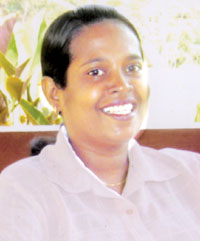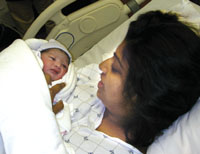
Hands and crafts blended with creative minds
Caryl Nugara
 CREATIVE
MIND: The discovery of cottage industry and handicraft conjures the
creative aptitude of women and men. This form of industry is often on a
small-scale and done mainly by hand or on simple machines like the
handloom in rural areas. CREATIVE
MIND: The discovery of cottage industry and handicraft conjures the
creative aptitude of women and men. This form of industry is often on a
small-scale and done mainly by hand or on simple machines like the
handloom in rural areas.
It dates back to peasants who found that it could be remunerate in
cash. For example, the Red Indians traded their embroidered moccasins
and beaded trinkets for corn, salt and sugar.
American pioneer women spun blankets with strips of flannel,
fashioned crazy patchwork quilts and even made corn-cob dolls dressed in
calico skirts and grey bonnets which they sold as they passed by towns
in their distinctive covered wagons.
Our own cottage industry consists of lace making to adorn womenâs
garments, table cloths, bed sheets and cushion covers. The trend now is
for lace shawls with bead work and fringes that sway provocatively on
the wearer.
Pot holders called âmacrameâ can hold your drapy plants attached to a
beam in the verandah. They are fashioned with coarse lace made by
knotting cords in a geometrical pattern.
Duffle bags and straw bags could be used when we go marketing. Cloth
purses to hold spectacles and pouches can contain make-up items and even
a vial of perfume. For children there are pencil cases and cloth bags
which last longer than plastic ones.
Batik is favoured by many people. Umbrellas, wall hangings,
âkaftansâ, and even bedside carpets reflect natureâs own shades of
ochre, green, brown and yellow. Brighter colours have been introduced. I
have seen skirts embroidered with tiny sea-shells and dried beads on the
hem line.
Handlooms turn out bed-linen, towels and coverlets. They are simple
and durable. You may buy attractive ornamental candles which when lit
emanate an oriental scent and satchets or net bags with mixed posies
within of dried flowers, fragrant spices and grass. When they are tucked
among your clothes they give a nice smell.
Attractive chains and bangles are made of coloured beads and a
sprinkling of glitter. Even the humble coconut shell has been turned out
into hair-combs, small bowls and ladles. Splendid ebony elephants and
ornaments have been given special care from the creator.
Familiar characters like the Kandyan dancer, the aristocratic
Sinhalese woman and man are made of clay with pigments to highlight
their clothing. Pots and vases of clay still continue to be done on the
âpotterâs wheelâ.
I like to mention an enticing display within a certain well-known
shopping mall which struck me. A real old-fashioned wooden cart rested
on its shaft. It was decorated with locally made and variegated
imitation jewellery, sparkling and twinkling in the light.
I believe that with some foreign collaboration and technology, our
people can produce more items to catch the eye of the tourist.
After all, these simple craftsmen and women have dreams, visions and
artistic things to create.
-------------------------------
A tale of guns and roses
Sumathipala Deeyagahage Southern Province roving
correspondent
|

EXCEPTION: Enoka Sanjeewani
Panditharathna
|
It is a case of guns and roses. A peculiar instance of a woman being
in charge of bombs, swords, grenades and guns; the epitome of affinity,
love and grace amidst destructive elements. But then, Enoka Sanjeewani
Panditharathna is an exception to the norm.
Enoka, hailing from Indurupathwila, Baddegama, is the officer-in-
charge of case productions at Galle High Court. She also acts as the
High Court Interpreter when the Interpreter goes on leave.
A few decades ago society expected women to be shy, not to be
outgoing or outspoken and to be confined to home. They were entrusted
with domestic chores and bringing up the children. But with women like
Enoka, the story does not read on the same lines any more.
Enoka obtained education at St. Anthonyâs College, Baddegama and
entered the Ruhunu University in 1995.
She fondly recalled an incident from her university days. âI got the
opportunity to read the case records of Kelaththawa, Mangala Eliya and
Thismada murders from a collection of newspapers about 40 years old. But
I never imagined that I would one day get involved in such criminal
cases officially,â she said. Following her graduation Enoka joined the
judicial service.
She recalled her first experience as an interpreter. âThe interpreter
was on leave and I was asked to cover his duties. I was excited and a
bit nervous. I called aloud the case numbers and the names of the
complaints and accused. The cases I read from the old newspapers rushed
into my mind. Case production is very crucial as certain cases depend
entirely on productions when there are no eyewitnessesâ.
|

WEAPONS HAUL: Galle High Court Judge Chandrasena Rajapaksha makes a
verification of the case productions to be destroyed before sending
them to be dumped in the deep sea. Enoka Sanjeewani, officer
in-charge of the case productions is also in the picture.
Pictures by Sumathipala Deeyagahage,
Southern Province roving correspondent
|
There was a large haul of productions collected over four decades.
The cases connected with these productions had been settled. It was
decided to destroy the productions by dumping them into the sea. The
productions included various kinds of firearms, bombs and explosives.
The help of the Navy was sought and a vessel provided by S.L.N.
Dhakshina Naval Base, Magalle transported the case productions to the
deep sea. âI got the opportunity to accompany High Court Judge
Chandrasena Rajapaksha on this mission. All case productions taken in
the vessel were dumped into the deep sea,â she said.
Enoka considers herself lucky to have the opportunity to serve under
HC Judge Rajapaksha. âWe can learn a lot from him to guide our lives on
the correct path,â she remarked.
Enoka is married to Priyantha Bataduwa Arachchi and has two children.
She has succeeded in striking the right balance between her career and
family.
-------------------------------
Style it the Indian way
1. Apply the make-up
2. Do a suitable hairstyle which brings out your natural beauty on
your wedding/engagement day. You should not change your face with
make-up and the hairstyle.
3. This is a modern hairstyle which is suitable for a indian style
saree draping. You can wear this hairstyle with lehenga (gagra choli) as
well.
4. When choosing jewellery a combination of Indian and Western
necklace is ideal. Your may wear an Indian style headdress.
5. This saree draping is little different from the normal. It has
been draped like a normal Indian saree but the fall has been brought to
the front and tucked in from the side.
-------------------------------
Pregnancy and arthritis:
Is it inherited?
Dr. Kaleel Cassim MBBS, MD (Medicine)
HEALTH: What are the chances of my child having arthritis?
 The
chances vary depending on the type of arthritis you have (see below).
With most forms of arthritis, the chances of passing it on to your
children are not very high, and there are many other factors involved in
the development of arthritis apart from simply the genes inherited from
the parents - for example, chance itself, joint injury, certain
occupations, smoking, being overweight, and environmental triggers. For
lupus, please see the separate section âLupus (SLE) and pregnancyâ. The
chances vary depending on the type of arthritis you have (see below).
With most forms of arthritis, the chances of passing it on to your
children are not very high, and there are many other factors involved in
the development of arthritis apart from simply the genes inherited from
the parents - for example, chance itself, joint injury, certain
occupations, smoking, being overweight, and environmental triggers. For
lupus, please see the separate section âLupus (SLE) and pregnancyâ.
Osteoarthritis: Most forms of osteoarthritis do not have a strong
tendency to be passed on from parent to child. That is, in most forms,
heredity plays a relatively small role compared with other factors such
as age, joint injury or being overweight.
However, one common form of osteoarthritis which does run strongly in
families is nodal osteoarthritis.
This mainly affects women and causes firm knobbly swellings, called
Heberdenâs nodes, on the joints at the ends of the fingers. Nodal
osteoarthritis also often causes a swollen thumb base - that is the
joint at the very bottom of the thumb, just above the wrist. Nodal
osteoarthritis often does not start until the 40s or 50s, around the
time of the menopause, so you may not develop it while you are of
child-bearing age.
If your own mother has nodal osteoarthritis, and you are female, you
have about a 1 in 2 (50%) chance of inheriting it yourself. And if you
have inherited it, your daughters would have a 1 in 2 (50%) chance of
developing nodal osteoarthritis themselves in middle life.
Rheumatoid arthritis: Although there is some tendency for rheumatoid
arthritis to cluster within families, the tendency to pass it on from
parent to child is not very strong.
To be continued
(The writer is Consultant Rheumatologist, Sri Jayewardenepura General
Hospital) |

